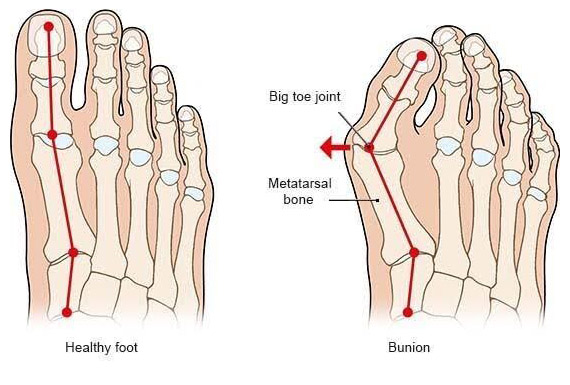Bunion and Bunionette Treatment in Singapore

Dr Seng Chusheng
Orthopaedic Surgery, Sports & Exercise Medicine
MBBS (S’pore), MRCS (Edin), MMed (Orth), FRCS (Edin)
What is a Bunion?


Dr Seng Chusheng
Orthopaedic Surgery, Sports & Exercise Medicine
MBBS (S’pore), MRCS (Edin), MMed (Orth), FRCS (Edin)
A Bunion is a bony bump that forms on the inner side of the foot at the base of the big toe. The skin over the bony bump usually appears red. This condition is often referred to by its Latin name, hallux valgus. The bony bump is usually a manifestation of a change in the alignment and structure of the foot, with the big toe pointing outwards towards the 2nd toe.
If the bump occurs on the outside of the foot at the base of the little toe, the condition is called bunionette.
What is a Bunionette (Tailor's Bunion)?
If the bump occurs on the outside of the foot at the base of the little toe, the condition is called a bunionette, or a tailor’s bunion. Although a bunionette is not as common as a bunion, they have similar causes and symptoms.

What are the signs and symptoms of bunions?
- Hard bony swelling of the big toe joint
- Redness and pain around the big toe joint
- Corns or calluses where the big toe rubs against the 2nd toe and under the big toe and 2nd toe
- Crossing over/overlapping 2nd toe
- Stiffness of the big toe joint if condition is advanced with arthritis
How Can I Reduce the Symptoms of Bunions?
Aside from bunion surgery in Singapore, there are some things one can do to relieve the symptoms of a bunion:
- Wear comfortable shoes, especially those that have the right fit and size (roomy)
- Observe or keep track of the feet’s shape as a child grows, especially for those who have bunions in their family
- Wearing high heels should be limited or avoided
- Rest one’s feet, especially after a long time of walking or standing
What Are the Causes of a Bunion?
Bunions may be hereditary, where a patient is born with a bunion-prone foot. Inappropriate footwear that is too small or tight with a narrow toe box or high heels may also worsen the condition; hence, women are more prone to having this condition. People with lax ligaments, flat feet and rheumatoid arthritis are also more likely to suffer from this condition.
What Are the Types of Bunions?
- Congenital hallux valgus: This is a type of bunion that is already present at birth
- Juvenile or adolescent hallux valgus: This refers to a bunion that forms during childhood. Young people aged 10 to 15 who are diagnosed with flat feet are more likely to develop this type of bunion.
- Tailor’s bunion: Also known as a bunionette, this type of bunion is smaller and develops on the outside at the end of the pinky toe, unlike the regular bunions that form on the big toe.
Who Is Prone to Getting Bunions?
Common risk factors that can increase the chances of developing bunions are:
- Genetics: Foot structure is often inherited, and people with flat feet, low arches, or abnormal bone structure may be more prone to developing bunions.
- Footwear: Wearing high heels and improper footwear, such as tight, narrow shoes that crowd the toes for extended periods, increases the pressure on the big toe.
- Obesity: Increased body weight puts more pressure on the feet, which may contribute to biomechanical stress and joint misalignment.
- Chronic Medical Conditions: Rheumatoid arthritis, osteoarthritis, and polio can alter bone and joint alignment, which can then affect how weight is distributed when walking.
- Age: It is more common among adults, ages 50 and beyond, due to joint degeneration. However, bunions can also occur in teens and young adults.
- Occupational Pressure: Occupations requiring extensive standing, walking, or repetitive foot stress, like teaching, nursing, and ballet, increase the risk of bunions.
- Gender: Women are more prone to developing bunions due to naturally weaker foot tendons and ligaments, frequent use of tight or high-heeled shoes, and hormonal changes during pregnancy that can loosen ligaments and flatten the feet.
When Should I See an Orthopaedic Doctor for Bunions?
Bunions can be painful, unsightly and inconvenient. When it comes to serious and symptomatic cases, you may wish to consult a bunion surgeon in Singapore when you observe the following:
- causes intense pain
- interferes with the individual’s capability to wear shoes
- results in a visible bump on the joint of the big toe
- limits motions on the foot or on the big toe
While bunions are generally harmless, they cannot go away naturally; thus surgery is essentially the only definitive way to remove bunions.
What Will the Doctor Do When I See Him to Evaluate Me for Bunions?
- The orthopaedic doctor will ask you about your symptoms and examine your foot
- He will also order an X-ray of your foot to determine the severity of the condition
What Are the Possible Complications of Bunions?
Though uncommon, having bunions may lead to complications, such as:
- Bursitis: This occurs when the small fluid-filled pads that cushion the joints become inflamed.
- Hammertoe: This refers to the abnormal bend that happens in the middle joint of the toe. This condition is caused by an imbalance of the muscles, ligaments, and tendons that hold the toe straight.
- Metatarsalgia: A condition wherein the ball of the foot becomes swollen and painful due to being involved in activities such as running and jumping, as well as wearing shoes that are too tight.
What Are the Treatment Options Available for Me If I Have a Bunion?
For mild and early cases, you may be advised to take the following steps to prevent further deterioration of your condition. These include:
- Proper footwear with a wide toe box and avoiding high-heeled shoes
- Use of orthotics such as bunion pads, bunion splints, and toe spacers to temporarily correct the alignment and reduce pain
- Over-the-counter pain medications that can reduce the pain and swelling around the affected big toe
- For severe cases, if you have a lot of pain while walking despite the measures described above, bunion surgery is the only effective way to treat the condition.
- 4-6 weeks of physiotherapy treatment may be given to patients to alleviate the pain and discomfort caused by bunions; though a change in appearance is unlikely.
Axis Orthopaedic Centre provides personalised bunion or bunionette treatment in Singapore – reach out to us for an appointment today.
What Are the Options for Bunion Surgery in Singapore?
Surgery may be required when bunion pain is severe and affects daily activities. Options include:
- Bunion surgery: Bunion surgery in Singapore, also known as hallux valgus correction, involves removing the bony bump and correcting the alignment of the big toe joint. Small cuts in the bones will be performed and fixed with small titanium screws to restore the alignment. Axis Orthopaedic Centre offers ‘keyhole’ minimally invasive surgery for mild to moderate bunions. It has the advantage of smaller scars and lesser pain and downtime. Open surgery is recommended for severe cases with very bad alignment.
- Bunionectomy: This is a type of bunion surgery that moves the toes back into their original position. By balancing the muscles around the joint, a bunionectomy ensures that the bunion will not develop again.
- Distal osteotomy: This procedure creates a V-shaped cut on the foot, specifically on the big toe, to correct the bones. Usually, this is a good option for large bunions whereby the toes and midfoot are still in proper alignment.
- Proximal osteotomy: In this procedure, a surgical cut is created near the base of the midfoot towards the ankle to move the bone inward, correcting the bunions.
Axis Orthopaedic Centre offers ‘keyhole’ minimally invasive bunion surgery for mild to moderate bunions. It has the advantage of smaller scars and lesser pain and downtime. Open bunion surgery is recommended for severe cases with very bad malalignment.
How will my recovery after bunion surgery be?
After the Singapore bunion treatment, you will be fitted with a special post-operative shoe to protect the bunion correction and allowed to walk.
You should keep your foot elevated as much as possible for the first few days after surgery to reduce swelling. It is common to have some swelling in your foot for a few months after bunion or bunionette surgery.
Full recovery after bunion surgery may take up to 3-4 months. During this recovery period, you should follow your doctor's instructions about weightbearing, and avoid strenuous physical activities such as running and dancing until he has given you the green light to do so.
What to Expect After Bunion Surgery
Bunion surgery is generally effective, but recovery and long-term results can be affected by several factors, especially the type of surgical method used and adherence to post-operative care.
These factors can affect how well the bone heals. With minimally invasive techniques, the risk of the bone not healing properly (a complication called non-union) is around 0.3%.
Recurrence rates are around 10–30%. However, proper rehabilitation, including physiotherapy and following your surgeon’s instructions, can significantly improve your recovery and help reduce this risk.




